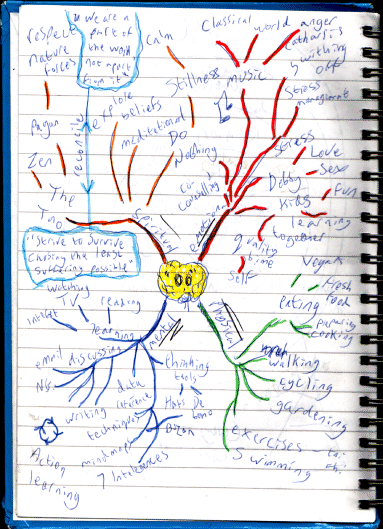A quick intro to mind mapping
I told you in an earlier post that I’d tell you about mind mapping. A mind map is a diagram that starts with a central word or concept, then spreads out to show how you visualize other words or concepts (or project tasks or images or anything else) connected to that. Mind maps are inherently non-linear, with the focus of the mind map in the center of the page and then everything connected to it moving out from there.
Mind maps are visual, so here are several examples of mind maps to give you a better idea of how they work. Note that these are mind maps about mind mapping, so they’re illustrating the connections between the core concept of mind mapping and the concepts and tasks associated with it. (Be sure to check out the source websites for additional information and resources on mind mapping.)
I’m impressed with the graphics on these; when I do a mind map, it’s usually much more sparsely illustrated, something like the following example:

As you can see, thought, the things that make mind maps most effective are to use lots of color and lots of illustrations. You not only have words and key concepts to hang your memories on, but the color and graphics make them easier to remember and make the concepts and relationships stand out. The right side of your brain thinks in pictures and colors far more than in words, so this technique gets both sides of your brain involved, increasing the depth of the associations on a subject.
In addition, you should put your thoughts down without trying to squeeze them into place in an arbitrary linear hierarchy. Mind mapping is a technique for getting your thoughts down on paper on a subject while recognizing that many concepts are not inherently linear. There are certainly many concepts that are dependent on other concepts, things that are linear and stepwise, but you don’t have to make things fit an outline that moves chronologically from A to Z just because.
In fact, if you think about it, outlining is most relevant for books or printed manuals… but if you’re creating an online help system or a web page or something else with hyperlinking and non-linear navigation, outlining presents a false structure. Mind maps are far more radial in their symmetry, frequently without a specific starting point from the central concept. The colors and graphics may give some clues, but it’s also possible that one starting point is as good as any other. Because the purpose of the mind map is to use visual and graphic elements to highlight relationships, the first two examples give a lot of information through the weight of the graphics.
Tony Buzan invented contemporary mind mapping. While there have been many pictorial record systems going back at least 2300 years, Buzan has popularized mind mapping in several books, such as Use Both Sides of Your Brain and The Mind Map Book. His techniques have also expanded on the connections between left and right brain activity and rung in software as well, for all of which is he richly deserving of credit.
Some other links worth checking out:
- Wikipedia (there’s always Wikipedia)
- A list of mind mapping software, both free and paid. (I don’t tend to use mind mapping software because I’m usually mind mapping when I’m taking notes or brainstorming on paper, so the process of doing the software takes too much effort that I could be using to write things down, leaping from concept tree to concept tree with a pen, but you may like it.)
- Information about FreeMind, the mind mapping software package I do use when I use one. (Here’s where to download FreeMind if you want to try it.)
- Information about Freeplane, another good mind mapping product (and a download link for Freeplane as well).
Mind mapping isn’t the tool you’ll want to use for everything, but it’s a great thing to know for breaking the bonds of a heirarchical outline. In fact, I will frequently mind map something first and then, with the concepts and relationships down on paper, I can start assigning weight, order, and presentation methodology in a linear outline. Try it out on some small piece of writing, such as an article or a blog post and see how it works for you.
Final tip: if you’re sweating too much over what goes where on the page, you’re putting too much thought into it. Mind mapping should be as light and quick as possible. Mind maps are usually a lot more fun than an outline because your right brain gets a chance to participate. If your pen is hovering over a section of the page too much, you’re probably stuck on something, so go do something else in another part of the mind map until whatever you’re trying to place pops up again.

